
Redefining Urban And Suburban America: Evidence From Census 2000 (james A. Johnson Metro Series)
by Robert E. Lang /
2005 / English / PDF
3.7 MB Download
Results from Census 2000 continue to reveal the striking changes taking place in the nation's cities and suburbs during the 1990s. Thanks to a decade of strong economic growth, concentrated poverty in inner cities declined dramatically, homeownership rose among young minority households, and workers from abroad settled in growing metropolitan areas that had experienced little immigration to date. This second volume in the Redefining Urban and Suburban America series makes clear, however, that regional differences add texture to these broader social and economic trends. Using data from the Census "long form," the contributors to this book probe migration, income and poverty, and housing trends in the nation's largest cities and metropolitan areas. Economically, the fast-growing Sunbelt and the Midwest performed well in the 1990s, enjoying declining poverty rates, rising homeownership, and the evolution of a solid middle-class population. Cities like San Antonio, Chicago, Houston, and Columbus saw stunning declines in high-poverty neighborhoods. The story was more mixed in the coastal areas of the Northeast and West, where poverty rates rose in cities such as Boston, New York, Washington, and Los Angeles. On net, their metro areas lost residents to other parts of the United States, even as they gained workers and families from abroad. This volume provides a closer look at the unprecedented social and economic changes taking place in the nation's oldest and newest communities, and explores the implications for a diverse set of policy areas, including metropolitan development patterns, immigrant incorporation, and the promotion of affordable housing and homeownershipThe results from Census 2000 continue to disclose remarkable population trends in the nations cities and suburbs during the last decade of the twentieth century. They confirm that American metropolitan areas lie at the heart of the nations most pronounced demographic and economic changes.
The first volume in the Redefining Urban and Suburban America series focused on population growth and decline, and the dramatic changes occurring in the racial and ethnic makeup of cities and suburbs. The second volume made clear that regional differences add texture to migration, income and poverty, and housing trends in the nations largest cities and metropolitan areas. This third volume in the series describes anew the changing shape of metropolitan America and the consequences for policies in areas such as employment, public services, and urban revitalization.
As decentralization of population and economic activity continued in most metropolitan areas, once-suburban areas have transformed into new engines of metropolitan growth, or "boomburbs." At the same time, some traditional central cities have enjoyed a population renaissance, thanks to the appeal of "living downtown," often close to workplaces and entertainment. The book's contributors probe the rise of these new growth centers and their impact on the metropolitan landscape. Volume three also provides a closer look at the social and economic impacts of growth patterns in cities and suburbs, including how suburbanization has affected access to employment for minorities and lower-income workers, the way that housing development influences central city population growth and decline, and how these patterns are shifting the economic balance between older and newer suburbs.











